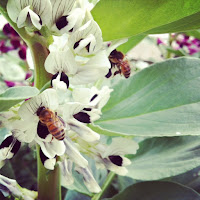The seasons in the Extremadura seem to be different every year. I have been living in Alcuéscar since 2011 and every season is a surprise. Having a vegetable garden, I am always very aware of the weather and the weather patterns. Everything I do in the garden is dependent on the weather that was and the weather that has to come. When to plant, what to plant and how to plant, it all hangs together with the rainfall, the temperatures, the day length etc.
 |
| celandine |
This year the winter was quite mild, in comparison with the last 4 that I have seen here. There was hardly any frost in the morning, and the day temperatures were mostly around 10 centigrades. Spring started therefore early, The first spring flowers appeared already in the beginning of January, like the celandine. Celandine is usually the first spring flower to appear. But soon other flowers followed and now, the beginning of March nature is at its best and there are flowers everywhere. The grass is green again and it is hard to imagine that the landscape will be brown and dry again in a few months.
 |
| white broom |
 |
| jara (rockrose) |
The evergreen bush of the Cistus or Rockrose (Jara in Spanish) is endemic to the Mediterranean region and grows abundantly in the Extremadura. The flowers appear normally in March, although this year a few bushes started flowering in early February. Many of the flowers show little chocolate or dark red spots on the petals. The bush itself is a bit sticky and when the sun warms the leaves, they spread a lovely spicy scent, so typical for the hot summer months in the Extremadura.
 |
| wild radish and common fumitory |
 |
| wild crocus |
 |
| camomile |

In the garden the wild flowers are also abundantly present. Although we always leave the borders of the finca and strips in the middle, we have to cut the gras and herbs regularly. The flowers that we leave are to attract bees. There are very little bees in our area and especially when there are so many flowers everywhere, it is hard to attract enough to our garden. In this season we need the bees to pollinate the broad beans. Many legumes are self pollinating, like peas and beans, but not the broad bean. The flowers of the broad beans spread a rich honey like scent. On a warm sunny afternoon the broad bean plants can be buzzing with bees.
 |
| dehesa with Los Gredos in the back ground |






 In the garden the wild flowers are also abundantly present. Although we always leave the borders of the finca and strips in the middle, we have to cut the gras and herbs regularly. The flowers that we leave are to attract bees. There are very little bees in our area and especially when there are so many flowers everywhere, it is hard to attract enough to our garden. In this season we need the bees to pollinate the broad beans. Many legumes are self pollinating, like peas and beans, but not the broad bean. The flowers of the broad beans spread a rich honey like scent. On a warm sunny afternoon the broad bean plants can be buzzing with bees.
In the garden the wild flowers are also abundantly present. Although we always leave the borders of the finca and strips in the middle, we have to cut the gras and herbs regularly. The flowers that we leave are to attract bees. There are very little bees in our area and especially when there are so many flowers everywhere, it is hard to attract enough to our garden. In this season we need the bees to pollinate the broad beans. Many legumes are self pollinating, like peas and beans, but not the broad bean. The flowers of the broad beans spread a rich honey like scent. On a warm sunny afternoon the broad bean plants can be buzzing with bees. 